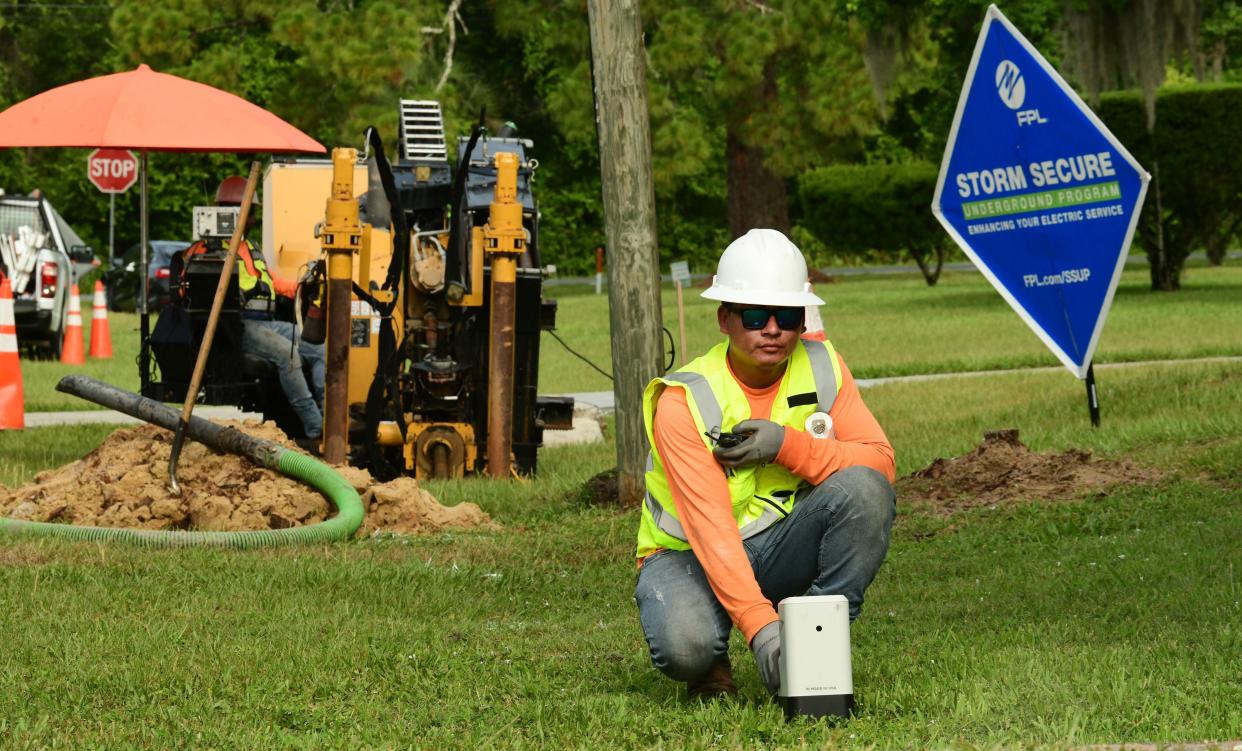Does it make sense for Florida to have any power lines above ground, given all the hurricanes?

Most of us with average power use pay an extra $5 on each energy bill to help 'harden' the grid. Taxpayers also gave Florida Power & Light Co. $200 million 15 years ago in federal economic stimulus money to make the grid more efficient and reliable, or "smart."
So how much harder, more reliable and smarter is it? Was it all worth it?
Florida Power & Light Co. officials say 'yes,' and that the payoff is happening now. In recent years, smart-grid technology helped avoid more than 600,000 outages combined during significant hurricanes, FPL says. And in Florida's $2.7 billion per day economy, time without power is money lost, not to mention all the other things that go awry in outages.
Now, NextEra Energy, FPL's parent company, is moving their smart grid underground to further prevent outages and economic losses. On Wednesday, FPL showed off the low-impact directional boring methods they'll use as they bury more underground lines in Mims and elsewhere, sometimes to the tune of up to $1 million per mile. Company officials say a similar array of automated switches underground can improve efficiencies in similar ways as they have above ground.
"It's almost like a chessboard," FPL Spokesperson Jack Eble said of the company's smart grid. "It helps us to be proactive."
About half of neighborhood power lines across FPL’s service area already are underground, company officials say. FPL serves 5.8 million customers, or about 12 million people.
The "undergrounding" or power lines that serve 130 customers in Mims is part of a 7-mile project expected to be completed by the end of this year. FPL has put power lines underground in about 250 neighborhoods in Brevard County since 2018.
FPL has more than 215,000 "intelligent devices" installed throughout its energy grid. Since 2011, the devices have helped avoid more than 13 million outages, FPL asserts.
Subprime crisis, federal stimulus forged FPL smart grid
In a way, the subprime mortgage crisis made it all happen. In 2009, FPL was awarded $200 million in federal Recovery Act "stimulus" money. It was among the largest stimulus grants received in Florida from the Obama administration. FPL put the grant toward its Energy Smart Florida project. Of the total, $40 million went to seven different types of distribution (main and neighborhood power lines, for example) smart-grid technologies in the South Florida area, company officials said.
FPL also touts a Storm Secure Underground Program that takes a data-driven approach to prioritize neighborhoods for undergrounding of power lines, based on past outage history during severe weather and service interruptions caused by trees and vegetation.
Seven years ago, FPL crews also began flying drones during storm response, to help with field surveillance of storm damage to become more efficient with their response.
FPL also uses LiDAR, a laser-scanning technology, that precisely maps the surrounding environment in three dimensions, alongside satellite imagery, to zero in on where power lines are most at risk from tree branches.
Underground lines benefit all FPL customers by reducing restoration costs and outage times associated with extreme weather events.
Almost 75% of Florida's energy comes from natural gas, but the company has plans to increase its solar power from the current roughly 6% to 38% by 2033 and has a goal of 30 million solar panels by 2030.
Storm Protection Plan
FPL is required by state law to have a storm protection plan that's approved by the Florida Public Service Commission.
Storm Protection Plan costs began in Jan. 2021 and is funded via about $5 on a typical residential 1,000-kilowatt-hour customer bill. That money is spent on hardening power lines, putting neighborhood overhead lines underground and installing smart-grid technology, FPL officials said.
Company officials say they continue to invest in a "stronger, smarter, more storm resilient energy grid" that helps to lower restoration costs, restore power faster following a hurricane and improve reliability for customers today and future generations. Over the past two decades, FPL’s overall reliability has improved approximately 40%, the company says.
“We see this as a strategic, long-term investment for our customers where they're going to see improved day-to-day reliability," said Mike Wertz, FPL Storm Secure Underground Program senior engineer, said of FPL's 'undergrounding' efforts. "And, when we do inevitably have hurricanes and severe weather events, we're going to see improved performance and reduced outage times for customers.”
While FPL does have arborists on staff and routinely trims trees around power lines, "It's also a shared responsibility of our customers," Eble said.
Learn how you can help prevent outages via your trees
“Right Tree, Right Place” program with helpful tips on vegetation management that we discussed: https://www.fpl.com/reliability/trees/tree-location.html
What is FPL doing to prevent hurricane outages?
Smart Grid – Installing more than 215,000 'intelligent devices' along the energy grid to detect and prevent outages and minimize restoration times during outages. In recent years, smart-grid technology helped avoid more than 600,000 outages combined during significant hurricane events.
Undergrounding – Replacing more overhead neighborhood power lines with morereliable underground lines through the Storm Secure Underground Program. These linesperform significantly better during severe weather, up to 12 times better during previoushurricanes.
Hardening – Strengthening nearly all main power lines serving critical communityfacilities and services. More than 76% of these lines are now hardened orunderground. FPL has also replaced nearly all of its transmission structures with steelor concrete.
Source: FPL
Contact Waymer at (321) 261-5903. Follow him on X (Twitter) at @JWayEnviro.
This article originally appeared on Florida Today: FPL says $200 million federal stimulus grant for smart grid beginning to pay off

